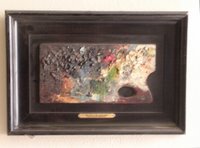Rembrandt
What is the best way to light the models in the Palette and Chisel workshops?
This issue was raised last night by a distinguished visitor,
Don Colley, when the monitor (myself) removed an overhead spotlight that was dear to him.
As I saw it -- the spotlight made the forms of the model too dark to see in shadow, and too bright to see in the light. And from where I was sitting, the pattern of cast shadow was not dramatic - it was just boring.
But since Don suggested that this kind of lighting might be found in old master drawings, I have created this blog entry to gather examples of favorite historic life drawings so we may speculate on the lighting -- - and I invite readers to submit their favorites as well.
Please DO NOT submit drawings that you do not really like.
Please DO NOT submit drawings unless they appear to have been drawn from life.
(rather than schematically constructed).
*******
It appears to me the first example, the Rembrandt shown above,
was probably lit by a gentle north light.
These flesh forms might better be revealed by a fluorescent fixture
rather than a single, strong spotlight.
In response to my above commentary, however, Larry Paulen, our drawing instructor, has pointed out that the sharp edge of the above cast shadow is evidence of a strong light source
Was Rembrant's model lit by direct sunlight that might be replicated by the use of a modern spotlight?
The detailed modeling in the areas of light suggest otherwise to me -- but more importantly, there appear to be two separate dark shapes on the left side of the right knee. One dark shape appears to be the shadow that the left knee casts accross the right one. But an even darker shape follows the edge of the left knee. It appears to relate to the composition of the drawing more than an observable shadow on the actual model.
Durer
This one has a stronger light - possibly the model is standing in a dark room beside a window on a sunny day. There also some strong secondary lights, possibly from other windows.
Possibly, multiple spotlights could render this effect.
Form appears to have been washed out in the areas of strong light,
but it remains detailed in the areas of shadow.
Ingres
This looks like a north light with secondary light - but we do have to allow for the artist drawing what he wants rather than restricting himself to what he sees.
Possibly multiple spotlights - or multiple fluorescents - would replicate this effect. - but they would have to be carefully located relative to the position of the artist.
Michelangelo
This one seems half way between a life study and
a schematic construction based on the artist's anatomical studies
It does not seem like the whole figure was lit by the same light(s)
Degas
This one could have been drawn beneath the florescent lights
of the Palette and Chisel third floor studio.
And I think I've drawn similar models in similar poses
about 10,000 times so far
in Palette and Chisel workshops.
Pontormo
I'm guessing that this light came from a large window in the wall of the studio.
Today, a spot light - or a row of them - might be used for this effect.
It's the only drawing shown, so far, where one part of the body has cast a strong shadow across another part of the body.
Rembrandt
A strong spotlight might create this effect.
Rubens
I sense an overhead light - but not a very strong one.
Today, the kind of indirect lighting fixtures that photographers use
might be applied.
Klimt
This discussion has gotten more traffic than anything else
I've ever posted to the internet,
so I had to borrow one of its images
as an example of great line drawing.
Obviously, a line drawing does not require a spotlight on the model.
But can a spotlight hurt?
I think so -- because even though the artist does not render
light falling across a form -- it still may be necessary for a subtle light to reveal that form
to the eye of the artist before rendered with a precisely drawn contour line.
***********
My conclusion: many different kinds of artificial lighting might be used
to replicate the light on the models in the above drawings.
But I would suggest that the stronger the light, the more care must be taken in the location of both the light and the artist - care which cannot be given when there are a dozen artists encircling a model
whose pose changes every half hour.
************
By the way, another issue was raised in last night's impromptu discussion.
Should monitors periodically stand for election
instead of being lifetime positions?
(just like renting a private studio)
Three of the workshops I regularly attend are monitored by someone other than myself. I'm doubting whether I would like those workshops any more if they had different monitors. They could be better -- but they also could be worse.
That may seem unfair to new members -- but if someone really wants to monitor, depending on the flexibility of their schedule, something usually opens up every year or so.
And I'm not sure that there is a surfeit of people who want to commit to monitoring a workshop 52 weeks a year. For example, there is nobody, now, who can make and honor that commitment for Wednesday night's drawing workshop. Job commitments keep the current monitor away for months at a time.
I monitored a Saturday morning sculpture workshop for about 10 years.
When I gave it up, it lay dormant for another 10 years until a newcomer picked it up.
The advantages of giving a new person a shot might be balanced against the disadvantage of slapping an older, reliable member in the face.
.
************
comments and suggestions are welcome!






















































